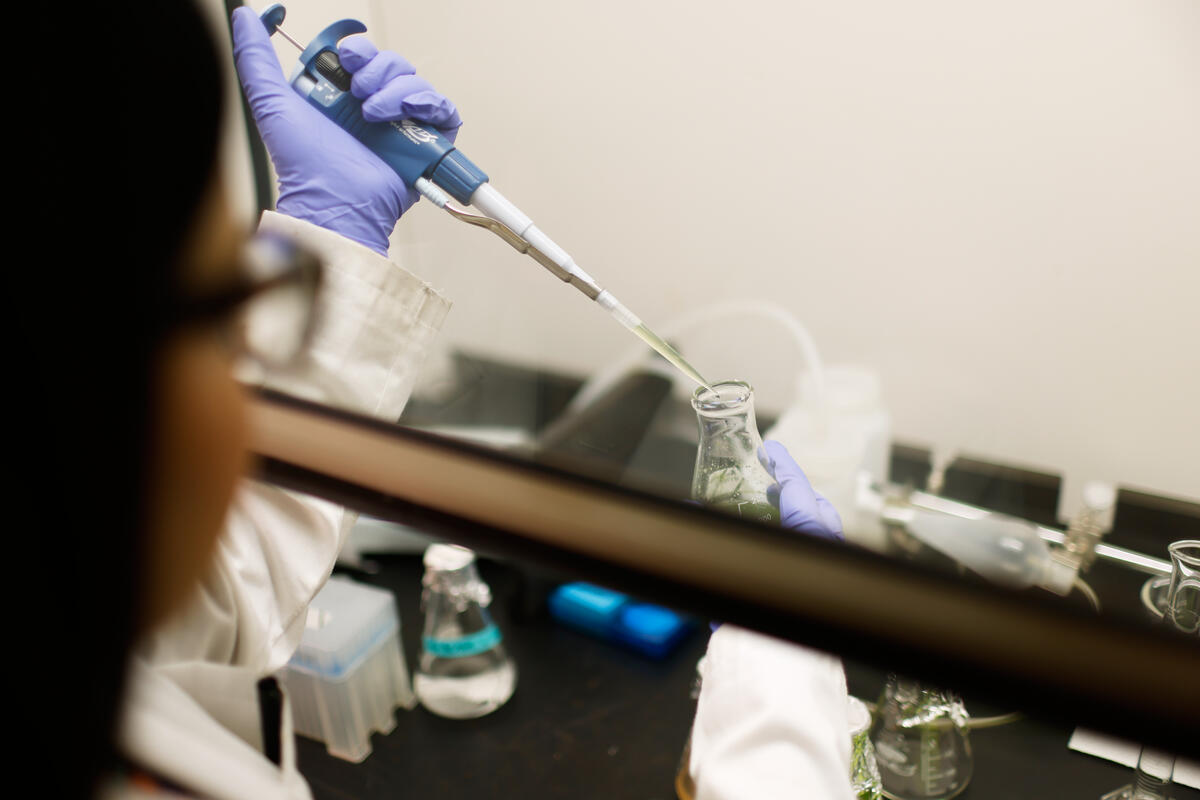While the world is marveling over the first images and data now coming from NASA’s Perseverance rover mission seeking signs of ancient microscopic life on Mars, a team of UNLV scientists is already hard at work on the next step: What if we could one day send humans to the Red Planet?
There’s a lot to consider when sending people, though. Human explorers, unlike their rover counterparts, require oxygen and food, for starters. It also takes about six to nine months — both ways — just in travel time. And then there’s the air itself. Martian air is roughly 98% carbon dioxide (Earth’s is a fraction of 1% for comparison) and the air temperature averages an extremely frigid -81 degrees.
It’s these challenges that UNLV geochemist and NASA Mars 2020 team scientist Libby Hausrath and postdoctoral researcher Leena Cycil, a microbial ecologist, are exploring. And a big part of the answer? Algae.

“Extremophilic algae” are types of algae known for their ability to thrive in extreme environments such as high-altitude snowy mountains or hypersaline lakes. These algae love carbon dioxide and can use it to produce oxygen. They also are edible, dense with nutrients, and grow quickly. Extremophiles’ helpful characteristics allow them to grow in some of the most inhospitable environments on Earth, possibly even in conditions similar to Mars.
“If we want to accomplish long-term space exploration with people instead of rovers and robots, it will require developing a self-sustaining life support system — food and breathable air,” says Cycil.
Hausrath and Cycil are among a handful of scientists looking at growing algae under the low-pressure, low-light conditions seen on Mars, and are pursuing different species than previous studies.
Early results are promising. So far, they’ve identified three species of algae that show substantial growth under extreme conditions. They used a low-pressure vacuum chamber to simulate atmospheric pressures relevant to Mars and topped it with a plate of tempered glass to allow light in at half the sun exposure present on Earth.
The three strains of algae are Dunaliella salina, which is typically found worldwide in salt lakes; Chloromonas brevispina, which exists in snowy climates; and Chlorella vulgaris, primarily used as a protein supplement or protein-rich food additive, which is often found in natural and engineered freshwater and soil habitats.
“We actually were surprised the algae grew at these low pressures. They may be thriving in these extreme environments on Earth, but the atmospheric pressure on Mars is considerably lower, so we were skeptical of what the outcome would be,” says Cycil.
Their findings on low pressure growth were published in Frontiers of Microbiology, with another publication on growing algae in low light levels coming in early 2023.
The team strategically studies one variable at a time to understand exactly how each affects growth.
They're isolating certain traits in each algae species to learn what combination of algae characteristics are best suited for Mars. For example, having algae that grow at low pressure is potentially more important than growth with a specific type of lighting because lighting is easier to manipulate than pressure. The hope is that the lab conditions could be recreated in greenhouses on the surface of the Red Planet.
“Understanding genetic adaptations that allow the algae to grow can help with the design of eventual life support systems and potential greenhouses on Mars,” says Hausrath.
Hausrath and Cycil are already working with a NASA engineer on applications for their work. Their study shows these organisms can produce oxygen at levels comparable to what people need to survive, but engineers will be the ones to put that into practice.
The Case for Algae
Hausrath and Cycil’s work is part of preparing for future short-term human exploration of Mars, where astronauts — instead of rovers — will conduct further experiments and gain more knowledge of the planet and its history. Ultimately, these visits will help determine if Mars can support human habitation.
“You could compare it to the space station missions paving the way for what we are seeing now in the commercialization of space flights. In time, commercial corporations will take our research toward manned long-term space travel and expand on it and what we know will grow exponentially,” explains Cycil. “We are learning from the rock and soil samples being returned from the rover mission, but there are other things we can’t accomplish with robotics.”
Future human exploration of Mars may need to depend on algae for both oxygen and food. Hausrath and Cycil believe algae could offer a great solution, as they do not take a lot of space to grow and can do well in microgravity situations too tough for traditional plants to survive. They’re healthy too, providing antioxidants, vitamins and minerals, and have the potential to provide both oxygen and nutrients to astronauts during spaceflight and while exploring the planet.
Although explorers of Mars would likely still rely on supply missions from Earth, the researchers believe that, considering the lengthy journey between planets, algae could bridge any gaps.



